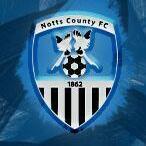
By super_ram

In this article I will try and show how football developed, slowly at first then suddenly took off in the second half of the 19th century as all the right conditions gradually came together and brought with it footballs first superstar. (Who could that be?) The first part shows how inventions and discoveries changed the lives of people living in the United Kingdom. The second part shows a timeline of events in footballs evolution. As before there are links to the previous articles for anyone who may have missed them or wishes to read again. I hope readers will bear with me as I recap a little and add more, hopefully interesting information in a chronological order.
Part 1 was about the formation of Notts County. Parts 2, 3 and 4 concentrated on, amongst other things, the formation of The Football Association, F.A. Cup, The Football League and professionalism.
So, 150 years ago on 15/1/1863 The Football Association was formed but it took events in the previous 100 years or so to make this possible.
Until the middle of the 18th century life in the UK had hardly changed for centuries.
The UK was a mainly rural society with most of the population working the land or from their homes and hardly venturing far from their villages, but with increasingly efficient methods of harnessing the power of water, factories and mills were built utilising this energy.
This was an age of invention and discovery with advances and improvements being made in all walks of life
The invention and further improvements of the steam engine accelerated the spread of mass organised production in factories and mills. These mills spread quickly where there was a ready supply of water, attracting workers and resulting in a migration of the population and thereby increasing the local population.
Improvements in agriculture increased the supply of food. Medical advances and better medical care reduced the infant mortality rate and raised life expectancy causing a rapid growth in the population.
Coal now became important as a means of heating the water for the steam engines and in the iron foundries and replaced wood as the UK's choice of fuel and luckily there was a plentiful supply of coal in many areas of the UK. This also helped create new communities and enlarge others, where coal mines flourished.
Now a new problem became apparent. How to transport all the raw material to the factories and mills, and then the distribution of the finished goods for export or around the UK.
The transport of large amounts of heavy material by road was slow and costly but the entrepreneurs during the industrial revolution came up with the idea of building canals to add to the river transport already in existence. One horse could haul a barge carrying much more cargo by canal than could be transported via road.
By 1830 a network of canals had been built in the UK in excess of 4000 miles.
Turnpike(toll roads) trusts were also set up to repair, maintain and sometimes build new roads to further aid the transport of materials and people.
The development of machine tools made better and more accurate mechanisation possible especially with the improvements made in the manufacture of iron and steel.
Another advance was the introduction of gas lighting. This was first used in London in 1807 and slowly spread throughout the UK reaching Nottingham in 1819. Now streets and interiors could be lit on a greater scale allowing factories and stores to operate longer and allowing nightlife to flourish.
In 1831 Nottingham became the first place in the world to have a high pressures mains water supply.
The Railway was one of the most important developments during the industrial revolution and was a great improvement on its predecessor - The wagonway.
Wagonways were carts drawn on track by horses. The earliest known wagonway was the Strelley - Wollaton line built in 1604 to transport coal from the Strelley mine to Wollaton where the coal was then moved by road to the River Trent for transportation down stream by barge.
The first public steam railway was built by George Stephenson and ran from Stockton to Darlington in the north east and opened in 1825.
The worlds first intercity link was the Liverpool to Manchester line opened in 1830.
Nottingham was linked by rail to Derby in 1839 and to Leicester the following year 1840
In 1830 there were only 98 miles of railways but by 1860 there were 10,000 miles and still expanding.
The new transportation now available also helped the rapid spread of ideas.
Between the early/mid 1700's and 1850 the UK population had risen from about 5,750,000 to nearly 17,000,000 (Liverpool from about 20,000 to about 376,000 and Nottingham from about 10,000 to about 58,000 (though this was only the central area and did not include much of what is now the City of Nottingham).
So now we can at last trace how football evolved from mob football to Soccer.
18th Century and before - Mob football - played on public holidays, with no rules and almost anything allowed short of murder.
Ball games played in public schools with varying rules.
1830 - Invention of lawnmowers - making the preparation of playing surfaces much easier.
1836 - Charles Goodyear patents vulcanised rubber and in 1855 produces a football.
1842 - First reference of a referee in a game in Rochdale
1845 - First time a referee is used in a public school match - at Eton College
1846 - Time limit for length of a match used in Lancashire games
1848 - Cambridge rules formulated in an attempt to unify the laws and enable inter-school games.
They included goal kicks, throw ins, forward passing and outlawed running while carrying the ball.
These laws were revised in 1856.
1849 - First reference of 3 officials in a match, at Cheltenham.
1850 - The 1850 Factory act - Gives workers free Saturday afternoons.
1857 - Sheffield FC formed - The worlds oldest club playing association football.
Sheffield rules formulated with free kicks, throw ins and a cross bar (previously a tape) across the goal posts and no off side.
1862 - Notts County formed - The worlds oldest league club playing Association football.
1863 - The Football Association formed and rules formulated. Playing area and goal size determined.
1865 - Nottingham Forest FC formed.
1866 - The offside rule introduced by the FA.
FA representative side play Sheffield FC using FA rules.
1867 - The Youdan Cup, the worlds first football tournament is played in Sheffield between 12
Sheffield Clubs with the final being played at Bramall Lane.
Sheffield FA introduce the corner kick.
Late 1860's - Passing strategies evolving.
1869 - Further amendment of FA rules with handling of ball being excluded except for throw ins.
1870 - First appearance of goalkeepers and teams set at 11 a side.
England draw 1-1 with a Scottish eleven at The Oval, though this is not recognised by FIFA as an official international as the Scottish team was made up mostly of Scots playing in England and was organised by the FA.
1871 - The FA Challenge Cup, the worlds oldest surviving knockout competition is established.
1872 - The Wanderers beat The Royal Engineers 1-0 in the first FA Cup Final.
England draw 1-1 with Scotland becoming the first FIFA recognised international match
The FA adopts the the Sheffield rule for corner kicks.
1873 - Goalkeeper restricted to handling the ball the in his own half of the pitch.
The Scottish FA formed.
The offside rule amended to now apply when the ball is passed not as before when received.
1874 - Referees given authority to send a player off for certain offences.
Shin guards(Shin Pads) invented by Samuel Weller Widdowson who played cricket for Nottinghamshire and football for Nottingham Forest. He cut down a pair of cricket pads and tied them inside his socks. He went on to become a referee and officiated the first match where goal nets were used and became chairman of Nottingham Forest - 1879-1884.
1875 - Goal crossbars first used.
1876 - Sheffield FA organises its own challenge cup. The final was watched by 8000 spectators - twice as many as the FA Cup Final of the same year.
1877 - FA adopt Sheffield FA throw in rule - The ball can now be thrown in any direction as opposed to a line out type throw as previously used.
Match duration now set at 90 minutes.
1878 - Experimental use of electric floodlights in a match at Bramall Lane.
Penalty kick first suggested by Sheffield FA but rejected.
Referees begin using whistle.
1880 - First official use of shin guards.
1882 - The 4 UK National Football Associations(England, Ireland, Scotland and Wales) meet to discuss unification of laws.
Two handed throw in introduced.
1883 - Accrington expelled from football association for paying players.
The International Football Association Board is formed at a meeting in Manchester by the 4 UK national associations.
Goal crossbar height set at 8 feet from the ground.
1884 - Preston North End given a 1 year suspension by The FA for paying players.
Rules are introduced by the FA in an attempt to prevent players being paid.
Northern clubs in favour of professionalism form The British Football Association in direct opposition to the FA.
The British Home Championship (The home internationals) is established between England, Ireland, Scotland and Wales with Scotland winning.
Derby County FC formed.
1885 - on 20th July The FA give in to pressure and legalise professionalism. (BFA now redundant)
1888 - The Football League formed.
Founder members - Accrington, Aston Villa, Blackburn Rovers, Bolton, Burnley, Derby County, Everton, Notts County, Preston North End, Stoke, West Bromwich Albion and Wolverhampton Wanderers.
The Combination football league formed in competition with The Football league comprising 20 teams but due to poor organisation was wound up in April 1889.
1889 - The Football Alliance formed with 12 clubs, the same number as the Football League, and covering roughly the same area comprising, Ardwick (Manchester City),Birmingham St. George, Bootle, Burton Swifts(not Albion), Crewe Alexandria, Darwen, Grimsby Town, Lincoln City, Long Eaton Rangers, Newton Heath(Manchester United), Nottingham Forest, Small Heath(Birmingham City), Stoke(City), Sunderland Albion(Not Sunderland FC), The Wednesday(Sheffield Wednesday and Walsall Town Swifts (Walsall FC).
1890 - Frank Whitby becomes the first professional playing for a southern team, Luton Town, being paid 2 shillings and sixpence(twelve and a half pence) plus expenses.
Irish FA propose introduction of penalty kick to the IFAB but again it is turned down.
The Combination reforms with Burton Swifts(not Burton Albion), Chester, Denton, Derby St. Lukes, Gorton Villa, Hyde,Leek(not Leek Town), Macclesfield Town, Northwich Victoria, Stafford County, Witton(Not Albion) and Wrexham.
In the Football League Sunderland replace Stoke who are not re-elected.
1891 - The referee moves to on field operation.
Football nets invented by Liverpool engineer John Alexander Brodie. After being trialed in a North v South match at Nottingham Forest's Town Ground they are adopted by the FA.
Assistant referees introduced as linesmen.
On the 14/2 /1891 Notts County were playing Stoke City in a FA cup quarter final tie. Notts were winning 1 - 0 when, with time running out, Notts left back, Jack Hendry, blatantly handled the ball preventing Stoke from scoring. The resulting free kick was easily saved and Notts won the match. This incident helped with the introduction of the penalty kick in the 1891/2 season.
Darwen are admitted to the Football league and Stoke are re-elected.
1892 - Stoke were again the victims of injustice while playing Aston Villa. With seconds remaining Stoke were awarded a Penalty kick but the Villa goalie kicked the ball out of the ground and by the time the ball was retrieved the referee had blown for time. The law regarding penalties was changed later in the season to allow time for penalties to be taken.
Football league expands to 28 clubs and forms a second division with the absorption of Football Alliance teams. Nottingham Forest, The Wednesday (Sheffield Wednesday) and Newton Heath join in the new first division with 16 club Darwen are moved to the new second division which also added, Northwich Victoria, Burslem Port Vale(Port Vale) and Sheffield United bringing the number of teams to 12, with Birmingham St George disbanding.
FA adopt penalty kick.
1893 - Football League 2 increased to 15 with the addition of Liverpool, Middlesbrough Ironopolis (Not Middlesbrouh FC), Newcastle United, Rotherham Town(not United) and Woolwich Arsenal (Arsenal),with Bootle resigning.
1894 - Bury, Leicester Fosse (Leicester City) and Burton Wanderers are admitted to Football League 2 but Northwich Victoria resign and Middlesbrough disband.
Referee given complete control of games.
1895 - Walsall Town Swifts are replaced by Loughborough.
1896 - Burslem Port Vale and Crewe Alexandria are replaced by Blackpool and Gainsborough Trinity.
1897 - Burton Wanderers are replaced by Luton.
Juventus FC formed.
1898 - Automatic promotion and relegation between leagues 1 and 2 introduced replacing test matches.
Football leagues 1 and 2 both now contain 18 clubs after the admission of Barnsley, Burslem Port Valle, Glossop and New Brighton Tower.
So there we are, the 20th century approaching and Football, more or less as we know it, well established and ready to spread around theworld.
All we need now are the players. Coming soon - 'Football's first superstar'
Discuss the Series - Super Rams Articles in the Community.
Previous Article | The Football League











Recommended Comments
Create an account or sign in to comment
You need to be a member in order to leave a comment
Create an account
Sign up for a new account in our community. It's easy!
Register a new accountSign in
Already have an account? Sign in here.
Sign In Now